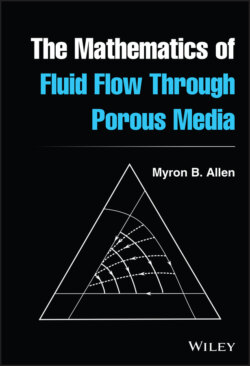Читать книгу The Mathematics of Fluid Flow Through Porous Media - Myron B. Allen III - Страница 24
2.3.2 Stress in Fluids
ОглавлениеThe stress tensor enjoys a richer set of possibilities. The simplest is the constitutive relationship for an ideal fluid, in which . Here, is a scalar function called the mechanical pressure, having dimension (force/area). The SI unit for pressure is 1 pascal, abbreviated as 1 Pa and defined as 1 kg . The symbol denotes the identity tensor. With respect to any orthonormal basis, the stress of an ideal fluid has matrix representation
(2.11)
Thus, in an ideal fluid, there are no shear stresses, and the fluid experiences only compressive and tensile stresses. Also, there are no preferred directions: . We describe this fact by saying that the stress tensor is isotropic. Section 3.7 discusses isotropic tensors in more detail.
For an ideal fluid in the presence of gravity, the momentum balance reduces to the following equation:
In problems for which inertial terms are negligible, for example when the fluid is at rest, this equation reduces to
(2.12)
Exercise 2.5 Integrate the third component of Eq. (2.12) to obtain the hydrostatic equation,
(2.13)
Thus pressure increases linearly with depth in an ideal fluid at rest.
Equation (2.13) closely models the pressure of Earth's atmosphere. At sea level, the pressure of the atmosphere fluctuates around Pa, which is the definition of a common unit of measurement, 1 atmosphere, abbreviated as 1 atm.
An extension of the ideal fluid stress provides a more realistic constitutive relationship for many fluids. An incompressible Newtonian fluid is a material for which
(2.14)
Here, stands for the stretching tensor, defined as
With respect to an orthonormal basis, the th entry of the matrix representation of is , and denotes the transpose of , whose th entry is .
The coefficient appearing in Eq. (2.14) is the dynamic viscosity, a nonnegative function of space and time having dimension . A common unit for measuring dynamic viscosity is the centipoise, abbreviated cP and named after the French physicist Jean Léonard Marie Poiseuille. In SI units, , which is approximately the viscosity of water at a temperature of C and a pressure of 1 atm. For comparison, the viscosity of air at these conditions is cP.
Exercise 2.6 Find the correct pronunciation of “Poiseuille.”
